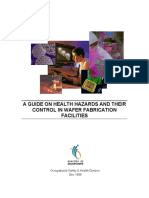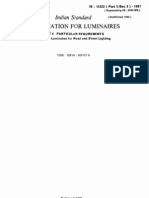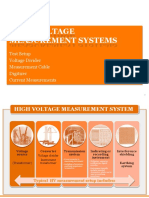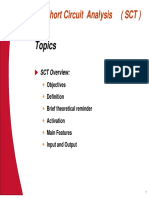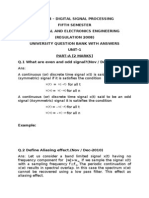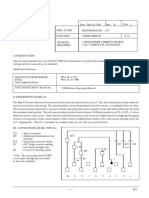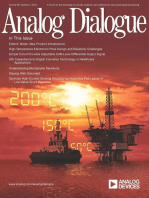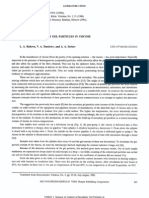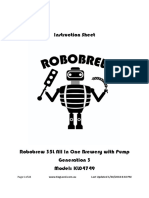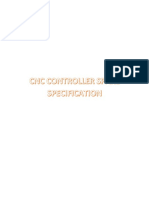0 ratings0% found this document useful (0 votes)
122 viewsLED Testing
LED Testing
Uploaded by
Saket JhaThe document discusses LM-79 testing which is used to test LED luminaires. LM-79 testing evaluates total luminous flux, efficacy, color temperature, color rendering index, and other photometric parameters using an integrating sphere. It also measures light intensity distribution using a goniophotometer. The testing is done in an accredited laboratory using approved methods to provide a report on all required electrical and photometric measurements. LM-79 testing is important for manufacturers to test and improve their products before selling in the market.
Copyright:
© All Rights Reserved
Available Formats
Download as PPTX, PDF, TXT or read online from Scribd
LED Testing
LED Testing
Uploaded by
Saket Jha0 ratings0% found this document useful (0 votes)
122 views22 pagesThe document discusses LM-79 testing which is used to test LED luminaires. LM-79 testing evaluates total luminous flux, efficacy, color temperature, color rendering index, and other photometric parameters using an integrating sphere. It also measures light intensity distribution using a goniophotometer. The testing is done in an accredited laboratory using approved methods to provide a report on all required electrical and photometric measurements. LM-79 testing is important for manufacturers to test and improve their products before selling in the market.
Copyright
© © All Rights Reserved
Available Formats
PPTX, PDF, TXT or read online from Scribd
Share this document
Did you find this document useful?
Is this content inappropriate?
The document discusses LM-79 testing which is used to test LED luminaires. LM-79 testing evaluates total luminous flux, efficacy, color temperature, color rendering index, and other photometric parameters using an integrating sphere. It also measures light intensity distribution using a goniophotometer. The testing is done in an accredited laboratory using approved methods to provide a report on all required electrical and photometric measurements. LM-79 testing is important for manufacturers to test and improve their products before selling in the market.
Copyright:
© All Rights Reserved
Available Formats
Download as PPTX, PDF, TXT or read online from Scribd
Download as pptx, pdf, or txt
0 ratings0% found this document useful (0 votes)
122 views22 pagesLED Testing
LED Testing
Uploaded by
Saket JhaThe document discusses LM-79 testing which is used to test LED luminaires. LM-79 testing evaluates total luminous flux, efficacy, color temperature, color rendering index, and other photometric parameters using an integrating sphere. It also measures light intensity distribution using a goniophotometer. The testing is done in an accredited laboratory using approved methods to provide a report on all required electrical and photometric measurements. LM-79 testing is important for manufacturers to test and improve their products before selling in the market.
Copyright:
© All Rights Reserved
Available Formats
Download as PPTX, PDF, TXT or read online from Scribd
Download as pptx, pdf, or txt
You are on page 1of 22
LED Testing
General Safety Testing for Luminaries
• Marking
• Construction
• External and internal wiring
• Provision for Earthing
• Protection against electric c shock
• Resistance to Dust, Solid objective and Moisture
• Insulation Resistance and electric Strength.
• Creepage and Clearances distances
• Endurance and Thermal Test
• Resistance to Heat ,Fire and Tracking
• Screw Terminals
• Screwless terminals and Electrical Connections
LM-79 TESTING LABORATORY IN INDIA
•It has a scope to test Solid state lightning luminaries for total luminous flux, efficacy, CCT,
CRI, color coordinates and LID.
•LEDs are boon to this contemporary epoch. It is widely used because of its innumerable
merits. Let us have a brief look at LED’s expediency to move further to discuss about the
Testing of luminaries as per LM 79.
•We can do the testing of your LED product against the different standard like LM 79 testing, IS
16106, IEC 60598-1, IEC 61347-2-13, IEC 62384, IEC62722-2-1, IEC 62031, IS
15885(part2/sec13), IS 16103, IS 16102, IEC 62612, and IEC 60969 etc.
•First and foremost, reason is its lastingness that is approximately 7 years for continuous use at
day and night. Another reason is the energy efficiency. LED is efficient to convert 90 %
of electrical energy to light energy with a little wastage in the form of heat energy produced
during operation. These are pocket friendly and give you relief while paying your electricity
bill. Apart from it, is the durability. The use of Semiconductors in LED make it more durable
as compared to Filament or neon gas lights .LED can resist high temp, jolt. Besides, LED are
environment friendly and safe to use. Because they are free from toxic chemicals and can be
totally recycled.
•In future LED is going to substitute incandescent lamp totally due to its list of benefits. All
industry and residential lightning is convinced to this technology and are implementing it by
replacing incandescent lamp with the LED. So, LED has an excellent future ahead.
WHY LM-79 TESTING AND IS IT COMPULSORY?
• If You are a manufacturer or vendor and want to sell your product in the market. Then
you must be needed a test report of your product which will give all the parameters
electrical and photometric measurement issued by an NABL accredited laboratory . LM
79 testing will give you a chance to improve your product by amendment in it if required.
So, Testing LED luminaries are a necessary task to be performed in this competitive
world.
• Of course, Yes! You must Go for LM 79 Testing, even on the usage of Tested LED in your
luminary. The LEDs are tested according to LM 80 which is a standard to test only LED’s.
But in Luminaries , LED is one of the components used in luminaries. The other
components of luminary are electrical, some connections, LED’s, optical, thermal and
mechanical that make it a new product and requires testing as per LM-79 Testing which is
a standard to test SSL and test the LED luminaries for measurements. To be competitive
and for good business, you need to test your product as per LM 79, as most of the
purchaser requires a test report and prefer to purchase Tested luminaries only.
• Now, it is clear LM 79 testing has a positive impact on the product. In brief, improvement
can be expected, quality enhancement, real picture performance criteria of the product,
help in enhancing business.
SCOPE OF LM-79 TESTING
• It covers the LED based Solid-state lighting (SSL) goods with control electronics and heat sinks
incorporated, that is, those devices that requires only AC main power or a DC voltage power
supply to operate. SSL products in the form of luminaries (fixtures incorporated light source) are
covered in LM-79 Testing. This standard describes the test methods for individual SSL products.
• It does not cover SSL products that require external operating circuits and external heat sinks
such as LED chips, LED packages and LED module. Even this document does not cover the fixtures
designed for SSL products sold without a light source and the performance rating of the product.
• LM-79 Testing provides us with the following parameters:
• 1. Electric parameters: Input Voltage , power, current , power factor, frequency
• 2. Photometry parameters: Luminous flux, Luminous Efficacy, Radiant power
• 3. CIE colorimetric parameters: chromaticity coordinates(x), chromaticity coordinates(y),
chromaticity coordinates(u’), chromaticity coordinates(v), chromaticity coordinates(v’),
Correlated color temperature(Tc), DUV Value, color rendering Index(Ra)
• 4. Light Intensity Distribution
Approved Method For LM-79 Testing
• It will be interesting to know about the approved method of LM-79 Testing. For photometric
parameters Integrating sphere is required and for Light intensity distribution Goniophotometer is
needed. A lab having both the machines and valid accreditation with full scope has authority to
issue Test reports presenting all the parameters present in the report discussed above.
• Approved Method to do LM 79 testing:
• Procedure and conditions.
• Maintained ambient temperature is 25°±1 °C with limited air flow.
• Power supply AC waveshape limit to harmonic RMS of 3%.
• Voltage regulation to ±2 %.
• Seasoning and stabilization (discussed below).
• Testing orientation.
• Electrical setting.
• Instrumentation
Detailed Understanding
• The total luminous flux (lumen) of SSL products shall be measured using an Integrating sphere or
a goniophotometer. The method may be chosen depends upon what is needed to be measured.
• For Small sized LED luminaries, the total flux and color measurements can be measured in
Integrating Sphere. There is no need of the dark room for installing Integrated sphere.
• The method of mounting can be the primary path for heat flow away from the device and can
affect measurements results significantly. The SSL under test must be mounted in integrating
sphere so that heat conditions through supporting objects causes negligible cooling effect. The
product may be held by support materials that has low heat conductivity like Teflon. Even the
supporting device does not disturb the air flow around the product. If any support is provided
with the SSL, then the product shall be tested with support structure attached.
• The SSL product under test shall be operated at rated voltage (AC/DC) according to the
specification of SSL. If the product has dimmable capability, measurements shall be performed at
maximum input power condition. If the product has multiple modes of operations including
variable CCT, measurement may be made at different mode of operation if necessary, and such
setting conditions shall be clearly reported. The integrated sphere owned by the ITC India Pvt is
having a Spectro-radiometer.
Detailed Understanding
• LM-79 Testing with integrating sphere system: First of all, the size of integrating sphere should be
large enough to ensure that the measurements errors because of baffle and self absorption. ITC has
Integrating sphere with dia 2 m. The integrating sphere shall be equipped with auxiliary lamp
(quartz halogen lamp) for self absorption factor. Before operating the integrating sphere must be
calibrated against the reference standard lamp calibrated for total spectral radiant flux. No
seasoning is required for new SSL products. Before measurements are taken, the SSL product under
test shall be operated long enough to reach stabilization and temperature equilibrium. The time
required for stabilization depends on the type of SSL product under test. The time ranges from 30
min to 2 or more hours for large SSL. The ambient temperature is maintained. The stabilization is
judged when variation ( max- min) of at least 3 reading of the light output and electrical power over
a period of 30 min, taken 15 min apart, is less than 0.5 %. Even the stabilization time used for each
SSL must be reported.
• The software generates the Lm-79 Testing report providing all the parameters: total luminous flux,
CCT, CRI, color coordinates discussed above except the light intensity distribution (LID).
• LM-79 Testing with Goniophotometer system: Now ,For LID measurements goniophotometer is
required, which is generally used for relatively large size SSL products. It also provides the total
luminous flux in lumen as well. Dark room is required for installation of Goniophotometer with
temperature control. Working on goniophotometer is time consuming as compared to Integrating
sphere.
• The LM-79 Testing report generated in Goniophotometer will provides all parameters including LID.
Detailed Understanding
• LM-79 testing requires complete luminaries testing on an absolute photometric basis. Typically
lighting products are evaluated on a relative photometric basis, where separate tests are done for
lamps luminaries. However, for solid state lighting products the LED lamps typically cannot be
separated from their luminaries. The absolute photometric testing required measures the light
distribution and light intensity of the complete luminaries.
• In recent times, the term LM-79 Testing laboratories have become part of our lighting lexicon and
have been treated in some cases as lighting program all its own. While many lighting programs
such as DLC and Energy Star reference LM-79 procedures, it is not in and of itself a lighting
program with specified requirements and pass/fail criteria.
• However, the term LM-79 Testing Lab has come to generally be recognized as two distinct tests –
a candela distribution test with an IES file, and an integrating sphere test for a standard color
(CCT, CRI, Duv, chromaticity coordinates).
Special Testing and certification schemes
• LED testing As per IS 15885 (PART-2/SEC-13):2012
• This standard ensures Safety of Lamp Control gear for LED Modules. The control gear specified in this standard is designed
to provide constant voltage or current at Safety Extra Low Voltage or (HV) higher voltages. Deviations from the pure
voltage and current types do not exclude the gear from this standard.
• This includes insulation resistance, electric strength, creepage distances and clearance between primary and secondary
circuits, along with:
• SELV Safety Extra Low Voltage control gears
• Auto wound control gear
• Protection against electric shock
• Isolating control gears
• Separating control gears
• LED testing As per IS 10322 (PART 5/SEC-1): 2012
• This Indian Standard was adopted by the BIS after the draft finalized by the Illumination Engineering and Luminaires
Sectional Committee had been approved by the Electrotechnical Division Council. This standard covers the safety and
photometric requirements. This series consists of photometric requirements that have been incorporated, that specify
requirements for fixed general-purpose luminaires for use with a tungsten filament, tubular fluorescent, LED Lights, LED
modules and other discharge lamps.
• LED testing As per IS 16102 (PART-1):2012
• IS 16102 Testing and certification specifying the safety and interchangeability needs, together with the test methods and
conditions, required to show compliance of LED Products, LED lamps with integrated means for stable operation,
intended for domestic and similar general lighting purposes. This standard ensures that the products cause no danger to
the user or surroundings.
Special Testing and certification schemes
• 16101: 2012 General Lighting – LEDs and LED modules – Terms and Definitions
• 16102(Part 1): 2012 Self- Ballasted LED Lamps for General Lighting Services Part 1 Safety
Requirements
• 16102(Part 2): 2012 Self-Ballasted LED Lamps for General Lighting Services Part 2 Performance
Requirements
• 16103(Part 1): 2012 LED Modules for General Lighting Part 1Safety Requirements
• 16103(Part 2): 2012 LED Modules for General Lighting Part 2 Performance Requirements
• 15885(Part2/Sec13): 2012 Safety of Lamp Control Gear Part 2 Particular Requirements Section 13
DC or AC Supplied Electronic Control gear for LED Modules
• 16104 : 2012 DC or AC Supplied Electronic Control Gear for LED Modules – Performance
Requirements
• 16105: 2012 Method of Measurement of Lumen Maintenance of Solid-State Light (LED) Sources
• 16106: 2012 Method of Electrical and Photometric Measurements of Solid-State Lighting (LED)
Products
• 16107(Part 1):2012 Luminaires Performance Part 1 General Requirements
• 16107-1:2012 Luminaires Performance Part 2 Particular Requirements Section 1 LED Luminaire
• 16108: 2012 Photobiological Safety of Lamps and Lamp Systems
General Requirements for LED Tube Light Testing and Certification and Procedure
1. Classification for LED Tube Light Safety Testing as per IEC 60598-2-1
• Type of protection Class 0 excluded Class II
• Degree of protection Requirement: Ordinary IP20
• Luminaire suitable for direct mounting on normally flammable
surfaces.
• Luminaire not suitable for direct mounting on normally flammable
surfaces
• Luminaire for normal use
• Luminaire for rough service
General Requirements for LED Tube Light Testing and Certification and Procedure
2. Marking for LED Tube Light Safety Testing as per IEC 60598-2-1:
• Mandatory markings
• Position of the marking
• Format of symbols/text
• Additional information
• Language of instructions
• Combination luminaires
• Nominal frequency in Hz 50/60 Hz
• Operating temperature
• Symbol or warning notice
• Wiring diagram
• Special conditions
• Metal halide lamp luminaire – warning
• Limitation for semi-luminaires
• Power factor and supply current
• Suitability for use indoors
• Luminaires with remote control
General Requirements for LED Tube Light Testing and Certification and Procedure
• Clip-mounted luminaire – warning
• Specifications of protective shields
• Symbol for nature of supply
• Rated current of socket outlet
• Rough service luminaire
• Mounting instruction for type Y, type Z and some Type X attachments
• Non-ordinary luminaires with PVC cable
• Protective conductor current in instruction if applicable
• Provided with information if not intended to be mounted within arms reach
• Test with water
• Test with hexane
• Legible after test
• Label attached
General Requirements for LED Tube Light Testing and Certification and Procedure
3. Construction
• Creepage distances and clearances
• Provision for earthing
• Screw terminals
• Screw less terminals and electrical connections
• External and internal wiring
• Protection against electric shock
• Endurance test and thermal test
• Resistance to dust, solid objects and moisture
• Insulation resistance and electric strength
• Resistance to heat, fire and tracking
For Initial Performance
LM-79 LED Luminaire Photometric and Electrical testing
• Applies to complete LED luminaires and lamps
• Tests for total light output, distribution, color, power, etc.
• Useful for consumer comparison of initial performance
• Widely adopted for use by most rating and information programs
• Currently under revision
For Long Term Performance and Reliability
• LM-80 LED Source Lumen Depreciation Testing
– Applies only to package, array, module components
– Works with TM-21 for lumen decay projection estimate
– Currently under revision
• TM-21 Projection of Source Lumen Depreciation
– Works with LM-80 data for lumen depreciation estimate
– Limited projection allowed
– Widely adopted (with LM-80) for use by most programs
For Long Term Performance and Reliability
TM-26 Methodologies for Projecting Failure Rate of LED Packages
– Defines consistent methods for projecting catastrophic failure rates
– Along with lumen degradation projections (i.e., TM-21) provides
useful information on LED package reliability
– Can be used to help understand LED product reliability
– NEW and close to publication so not yet applied
For Long Term Performance and Reliability
LM-82 LED Light Engines and Lamp Photometric and Electrical testing
at temperature
– Applies to complete LED Light Engines and lamps
– Tests for total light output, distribution, color, efficacy, etc. at a
specific temperature
– For use primarily for manufacturers of LED end products (lamps,
luminaires) to verify performance
– NEW (just published) and not yet widely applied
For Long Term Performance and Reliability
NEMA SSL-7a Dimming SSL Luminaires with Phase Cut Dimmers
– First of hopefully several that help define effective dimming for LED
products
– For use primarily for manufacturers of LED end products (lamps,
luminaires) to verify performance
– NEW (just published) but not yet widely applied
For Long Term Performance and Reliability
• LM-84 LED Light Engine and Lamp Lumen Depreciation Testing
– Applies primarily to “light engine” components
– Works with TM-28 for lumen decay projection estimate
– NEW and close to publication so not yet applied
• TM-28 Projection of Light Engine and Lamp Lumen Depreciation
– Works with LM-84 data for lumen depreciation estimate
– NEW and close to publication so not yet applied
For Long Term Performance and Reliability
• LM-85, LED Reliability Tests
– Intended to provide consistent testing for package reliability
• LM-86 measurement of remote phosphor products
– Remote phosphor (compared to integral phosphor products have
different test issues
• S408-11 Optical Waveform Measurements
– Useful for flicker and similar measurement issues
• S412-13 Color Point Stability
– Useful in understanding color shift issues over time
You might also like
- Diagrama International VT365Document2 pagesDiagrama International VT365Edwin Motta Piamba89% (57)
- Kapil DhamaDocument2 pagesKapil DhamaStatusPediaNo ratings yet
- LED Standards and Methods of MeasurementsDocument64 pagesLED Standards and Methods of MeasurementsGerardo Cardozo MéndezNo ratings yet
- Industrial Applications of Infrared Thermography: How Infrared Analysis Can be Used to Improve Equipment InspectionFrom EverandIndustrial Applications of Infrared Thermography: How Infrared Analysis Can be Used to Improve Equipment InspectionRating: 4.5 out of 5 stars4.5/5 (3)
- Electrical Engineering Interview QuestionsDocument17 pagesElectrical Engineering Interview QuestionsEdisonNo ratings yet
- A Guide On Health Hazards & Their Control in Wafer Fabrication FacilitiesDocument42 pagesA Guide On Health Hazards & Their Control in Wafer Fabrication FacilitiesDarrenGCGNo ratings yet
- A Center-Fed Electric Dipole of Length L Is Attach...Document5 pagesA Center-Fed Electric Dipole of Length L Is Attach...qasimNo ratings yet
- LM79Document2 pagesLM79Prem AnandNo ratings yet
- Trillion Dollar Cable QuestionDocument6 pagesTrillion Dollar Cable QuestionGualadrakeNo ratings yet
- IS 10322: 1987 (Part 5 / Sec 3)Document11 pagesIS 10322: 1987 (Part 5 / Sec 3)ychodneker0% (1)
- PS7203-Advanced Power System ProtectionDocument6 pagesPS7203-Advanced Power System ProtectionntrimurthuluNo ratings yet
- Uniformity RatiosDocument27 pagesUniformity RatiosApurve Pratap SinghNo ratings yet
- Sukrut: Oil Level IndicatorDocument2 pagesSukrut: Oil Level IndicatorvipulpanchotiyaNo ratings yet
- Psps Unit 1 QBDocument9 pagesPsps Unit 1 QBNaveen RajNo ratings yet
- A Fast Method For Calculation of Transformers Leakage Reactance Using Energy TechniqueDocument8 pagesA Fast Method For Calculation of Transformers Leakage Reactance Using Energy TechniqueGame MiNo ratings yet
- IS-2071, Part-1Document78 pagesIS-2071, Part-1Himansu Sekhar JenaNo ratings yet
- Type 2 CoordinationDocument7 pagesType 2 CoordinationSatya Prakash Barik100% (1)
- Modulex3 PDFDocument2 pagesModulex3 PDFRazvan SasuNo ratings yet
- SGP Question BankDocument3 pagesSGP Question BankSanjay Agrawal0% (1)
- KYN61-40.5 Indoor Removable AC Metal-Clad SwitchgearDocument1 pageKYN61-40.5 Indoor Removable AC Metal-Clad SwitchgearCLAVOTNo ratings yet
- Co-Po-Pso MappingDocument19 pagesCo-Po-Pso MappingAjayNo ratings yet
- Checklist PC PDFDocument2 pagesChecklist PC PDFsgshekar30No ratings yet
- Susol VCB E 1405Document220 pagesSusol VCB E 1405tawanda1984No ratings yet
- Chapter 7 Measurement of High VoltageDocument20 pagesChapter 7 Measurement of High VoltageTeh chia NienNo ratings yet
- Armónicas en Sistemas Eléctricos: Estandar IEEE-519Document12 pagesArmónicas en Sistemas Eléctricos: Estandar IEEE-519gctdNo ratings yet
- HT Turorial Question BankDocument16 pagesHT Turorial Question BankA. AnsarNo ratings yet
- TR231 or TR241 - 8112W00089 PDFDocument1 pageTR231 or TR241 - 8112W00089 PDFnk1224No ratings yet
- Reprocessing of Nuclear FuelDocument70 pagesReprocessing of Nuclear FuelDharmendraKumarNo ratings yet
- BhagvatGita in Gujarati Hardik123Document385 pagesBhagvatGita in Gujarati Hardik123hardik123No ratings yet
- Rcm14-03 Ac/Dc Residual Current Monitor: Making Electricity Safer by DesignDocument2 pagesRcm14-03 Ac/Dc Residual Current Monitor: Making Electricity Safer by DesignAli Lakrakbi100% (1)
- Wireless Power Transfer For Electric Vehicle Battery Charging MiniprojectDocument20 pagesWireless Power Transfer For Electric Vehicle Battery Charging MiniprojectAlisha AnjumNo ratings yet
- Is 10322-5-1 (Bis)Document8 pagesIs 10322-5-1 (Bis)Prabhat mani tripathiNo ratings yet
- Sukrut: Oil Level IndicatorDocument2 pagesSukrut: Oil Level IndicatorvipulpanchotiyaNo ratings yet
- Short Circuit Anaysis - AREVADocument28 pagesShort Circuit Anaysis - AREVAJoseph FaresNo ratings yet
- ABB Micro SCADA - BrochureDocument2 pagesABB Micro SCADA - BrochureNo RegreTsNo ratings yet
- EE 2402 - QB ProtectionDocument7 pagesEE 2402 - QB ProtectionArun Bharath RajaNo ratings yet
- InfiniSolar Super 4KW Manual 20160420Document60 pagesInfiniSolar Super 4KW Manual 20160420Ussama Abbas100% (1)
- History Summer09 PDFDocument7 pagesHistory Summer09 PDFhizbi7No ratings yet
- An Iot Based Air Pollution Monitor SystemDocument29 pagesAn Iot Based Air Pollution Monitor Systemblessingj19it018No ratings yet
- Reactive Power SlidesDocument15 pagesReactive Power SlidesfaanilasaaniNo ratings yet
- DSPDocument15 pagesDSPbbmathiNo ratings yet
- EE1402 Power System Protection and SwitchgearDocument8 pagesEE1402 Power System Protection and Switchgearmoonsoon_j100% (1)
- Metals Analysis in TransformersDocument3 pagesMetals Analysis in TransformersdchyNo ratings yet
- 7SD610 enDocument328 pages7SD610 enAnonymous m65TTcfOTNo ratings yet
- 245kV & 145kV CB-MSETCLDocument55 pages245kV & 145kV CB-MSETCLVenkatNo ratings yet
- EMF 52-84 enDocument2 pagesEMF 52-84 enSnTCrashNo ratings yet
- Introduction To Time Series Analysis, LecturesDocument49 pagesIntroduction To Time Series Analysis, LecturesnumenoreNo ratings yet
- Manual For VLF Sinus TDM 62Document48 pagesManual For VLF Sinus TDM 62vutuananh.hp8788No ratings yet
- Please Explain The Principle of Weak InFeed Echo Permissive Over Reach Transfer Trip Schemes - Valence Electrical Training ServicesDocument26 pagesPlease Explain The Principle of Weak InFeed Echo Permissive Over Reach Transfer Trip Schemes - Valence Electrical Training Servicesforwork 123No ratings yet
- Harmonic CurrentDocument8 pagesHarmonic Currentiam_dausNo ratings yet
- Circuit Breaker Specifications Mentioned On Its NameplateDocument13 pagesCircuit Breaker Specifications Mentioned On Its Nameplatearyo bimo surya putraNo ratings yet
- HP-AN1304-2 - Time Domain Reflectometry TheoryDocument17 pagesHP-AN1304-2 - Time Domain Reflectometry Theorysirjole7584No ratings yet
- Tracking A Sine Wave: Fundamentals of Kalman Filtering: A Practical ApproachDocument83 pagesTracking A Sine Wave: Fundamentals of Kalman Filtering: A Practical ApproachKhalil UllahNo ratings yet
- Wireless Monitor For Surge ArresterDocument4 pagesWireless Monitor For Surge ArresterDong BachNo ratings yet
- Health and Capacity Testing of DC Battery BankDocument5 pagesHealth and Capacity Testing of DC Battery BankKrishna KumarNo ratings yet
- DSP Te1 Answer KeyDocument21 pagesDSP Te1 Answer KeyshankarNo ratings yet
- F2000 Instruments Relay Test PlanDocument4 pagesF2000 Instruments Relay Test Planyand_carlosNo ratings yet
- Code of Practice For Design, Installation and Maintenancefor Overhead Power LinesDocument22 pagesCode of Practice For Design, Installation and Maintenancefor Overhead Power LinesStarla HillNo ratings yet
- Lab SphereDocument44 pagesLab SpherefmtzvargasNo ratings yet
- WP007 LED Luminaires Stds OverviewDocument3 pagesWP007 LED Luminaires Stds OverviewKushal BhanushaliNo ratings yet
- Labsphere PDFDocument44 pagesLabsphere PDFfmtzvargasNo ratings yet
- LM 79 Test Reports Webcast Presentation 1Document29 pagesLM 79 Test Reports Webcast Presentation 1ashleyschappertNo ratings yet
- IES TM 21 11 StandardDocument51 pagesIES TM 21 11 StandardmcfmtzvargasNo ratings yet
- Sgs India Private Limited Full and Final For The Month of Mar 2021Document2 pagesSgs India Private Limited Full and Final For The Month of Mar 2021Saket JhaNo ratings yet
- Month (20chanderia Reject Debari Reject Dariba Reject Monthly RejectDocument2 pagesMonth (20chanderia Reject Debari Reject Dariba Reject Monthly RejectSaket JhaNo ratings yet
- Bharatmala ProjectDocument15 pagesBharatmala ProjectSaket Jha50% (2)
- Registration Number: AhmedabadDocument2 pagesRegistration Number: AhmedabadSaket JhaNo ratings yet
- Simssbmb1b Lva1 App6892Document12 pagesSimssbmb1b Lva1 App6892Saket JhaNo ratings yet
- Consideration: The Essential Element of Valid Contract: A Report For The CourseDocument4 pagesConsideration: The Essential Element of Valid Contract: A Report For The CourseSaket JhaNo ratings yet
- Sales of Goods ACT, 1930: - Somya Tiwari Assistant Professor Shri Ram Murti Smarak International Business SchoolDocument48 pagesSales of Goods ACT, 1930: - Somya Tiwari Assistant Professor Shri Ram Murti Smarak International Business SchoolSaket JhaNo ratings yet
- Qualification & Experience Criteria For Positions Under The Faculty of Engineering & Technology - 0Document2 pagesQualification & Experience Criteria For Positions Under The Faculty of Engineering & Technology - 0Saket JhaNo ratings yet
- 5302.0 Balance of Payments and International Investment Position, Australia Table 1. Balance of Payments, Summary: Original - QuarterDocument39 pages5302.0 Balance of Payments and International Investment Position, Australia Table 1. Balance of Payments, Summary: Original - QuarterSaket JhaNo ratings yet
- Lectures 3 4Document30 pagesLectures 3 4Saket JhaNo ratings yet
- 000249Document28 pages000249Saket JhaNo ratings yet
- Pipe Welding: Subject:-Welding Technology (2ME704/2)Document14 pagesPipe Welding: Subject:-Welding Technology (2ME704/2)Saket Jha100% (1)
- Estimation and CostingDocument44 pagesEstimation and CostingSuhasini Pranay100% (2)
- L&T Ball ValveDocument12 pagesL&T Ball ValvecdsenthilNo ratings yet
- Siemens Power Engineering Guide 7E 328Document1 pageSiemens Power Engineering Guide 7E 328mydearteacherNo ratings yet
- NCHRP Project 9-33: A Mix Design Manual For Hot Mix Asphalt: NEAUPG Fall Meeting October 18, 2007 Mystic, ConnecticutDocument20 pagesNCHRP Project 9-33: A Mix Design Manual For Hot Mix Asphalt: NEAUPG Fall Meeting October 18, 2007 Mystic, ConnecticutgadNo ratings yet
- Mid2 Objective PaperDocument2 pagesMid2 Objective PaperChilla DivyaNo ratings yet
- Weld SymbolsDocument63 pagesWeld SymbolsAyub KhanNo ratings yet
- Formation of Secondary Gel Particles in ViscoseDocument3 pagesFormation of Secondary Gel Particles in ViscoseAditya ShrivastavaNo ratings yet
- Product Catalogue BatteryDocument24 pagesProduct Catalogue BatteryPrakash SinhaNo ratings yet
- Determination of Molecular Weight of MacromoleculesDocument8 pagesDetermination of Molecular Weight of MacromoleculesKaaya Godfrey100% (1)
- P132 CortecDocument2 pagesP132 CortecAshley OsbornNo ratings yet
- Supply Chain Council & Supply Chain Operations Reference (SCOR) Model OverviewDocument29 pagesSupply Chain Council & Supply Chain Operations Reference (SCOR) Model OverviewOUKahn100% (1)
- Chapter 12Document7 pagesChapter 12gulyaNo ratings yet
- What Is The Difference Between Diffusion and Radiation Heat TransferDocument9 pagesWhat Is The Difference Between Diffusion and Radiation Heat TransferKhalid AlmashikhiNo ratings yet
- Design and Study of Inset Feed PDFDocument7 pagesDesign and Study of Inset Feed PDFVijaya ShreeNo ratings yet
- Sarah Sanchez ResumeDocument2 pagesSarah Sanchez Resumeapi-227315242No ratings yet
- MC15 Cri Cri Plans Binder PDFDocument44 pagesMC15 Cri Cri Plans Binder PDFOscar Oreste Salvador CarlosNo ratings yet
- 2sk3255 - 900V, 5ADocument1 page2sk3255 - 900V, 5ARenatoMaiaNo ratings yet
- Thesis On Parameter Optimization of Injection Moulding For Polypropylene (PP) Toothbrushusing Taguchi MethodDocument89 pagesThesis On Parameter Optimization of Injection Moulding For Polypropylene (PP) Toothbrushusing Taguchi Methodshambhu kumar singh0% (1)
- Instruction Sheet: Last Updated 1/30/2018 8:44 PMDocument22 pagesInstruction Sheet: Last Updated 1/30/2018 8:44 PMMiguelAguirreNo ratings yet
- Comp108 - Introduction To Computer ArchitectureDocument25 pagesComp108 - Introduction To Computer ArchitectureBorotho MolemoNo ratings yet
- Rotating Equipment Course: Compressor ComponentsDocument11 pagesRotating Equipment Course: Compressor ComponentsAnton IonutNo ratings yet
- Autodesk Inventor 2015 Certification RoadmapDocument2 pagesAutodesk Inventor 2015 Certification RoadmapNugroho Adhi SaputroNo ratings yet
- CapstoneDocument5 pagesCapstoneMarcus Rowenn Albios SalesNo ratings yet
- Instalação - Motor 3054Document5 pagesInstalação - Motor 3054carlos nogueiraNo ratings yet
- CNC ControllerDocument12 pagesCNC ControllerMihai ViteazuNo ratings yet
- Exam Tutorial - Adobe Premiere ProDocument32 pagesExam Tutorial - Adobe Premiere ProNikita SenNo ratings yet





